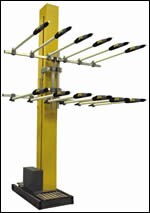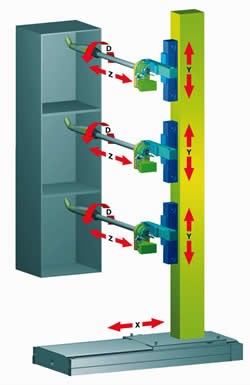All the Right Moves
Tips For choosing a powder gun movement system
Powder coating today is not the same as it was 10 or even five years ago, yet many still believe, incorrectly, that the equipment is the same as it has always been.
Any finisher would pay careful attention to appropriate gun technology and movement in liquid paint applications where the paint may cost $100/gal and any overspray is lost. However, many powder coating shops believe that powder costs of $3/lb and the fact that they are reclaiming means they can use less care in the powder application process.
This is a costly assumption. More careful attention paid to available powder coating technology available today can save money and reduce reject rates, and relatively low-cost investments in equipment can show quick returns.
Equipment Advances
Advances to powder coating application equipment just in the last couple of years have changed the way most powder coating lines should be run.
Changes to soften powder delivery, new means of moving the guns, and different types of powder pumping technologies, as well as improvements to booths and availability of better color change technologies, have improved first-pass transfer efficiency anywhere from 10–40%. Additionally, better and more precise control systems, in conjunction with new gun designs, ensure more uniform coating thicknesses as well as lower cost of equipment ownership. But there’s a catch: to take advantage of the available savings, shops no longer can use the same old application techniques simply because “that’s the way we have always done it.”
One of the most important areas to review as you take advantage of the technology changes available is in the area of gun placement and movement technology. In North America, powder guns traditionally were either fixed or placed on simple oscillating gun movers. The idea was to create a cloud of powder that the parts would pass through to be coated.
Distance from the gun to the part was not as important in the past as it is today with the new designs of booths and guns. To take advantage of new softer powder delivery and soft air flow in booths around the parts, the gun-to-part distance has been reduced. Simply blowing large amounts of powder into the booth is no longer the desired approach. Proper selection of a gun mover will greatly impact the effectiveness as well as the cost of operation of your powder system.
So what are the options? They run the gamut from the traditional ways as well as newer, higher-technology approaches. Gun movement alternatives include:
- Fixed guns
- Oscillation and radial oscillation
- Short- and long-stroke reciprocation
- Multi-axis movement.
Following is a brief look at the advantages and limitations of each technology.
Fixed Guns
Fixed guns are best used for complex parts where a large number of automatic guns with close gun centers can be employed, or when a specific area on a part must be coated. In conjunction with automatic “in and out” movement, this approach can focus on the part areas that require coating by maintaining optimal distance between the guns and the part.
Fixed guns can also be used in applications where the part is moved and the guns are fixed, such as rotating parts on either an overhead conveyor or a chain-on-edge conveyor.
Limitations of fixed guns include difficulty coating large, flat parts, where overlapping gun patterns can cause streaking or striping. It is also critical that fixed guns are adjusted correctly to achieve the desired coating uniformity.
This approach leaves no margin of error in gun performance, and many applications using it address potential problems by spraying more powder than is necessary, wasting powder and increasing the overall operational costs of the system.
Oscillators
Oscillators move the guns up and down, typically using a simple mechanical system. Radial oscillators move the automatic guns on a pivot point in an arc path. These types of gun movement are typically used when precise control of the powder cloud is not required.
Oscillation technology was developed as the first step in the process to overcome problems seen on certain applications with fixed guns. Oscillators typically have limited ability to vary gun movement, including speed or stroke length.
The majority of oscillators will have a maximum stroke length in the 18–24 inch range. This allows for a low-cost gun mover but constantly changes gun-to-part distance and speed at the extreme of the strokes, but in turn limits the consistency of powder application.
Most oscillators do not include electronic movement control, making automated changes of gun movement impossible. These types of units can also be used in conjunction with automatic “in and out” movement, but have the same limitations as the fixed gun approach.
The primary reason coaters choose the oscillator movement approach is to overcome the streaking seen with fixed guns, and oscillators will provide some margin of error in gun performance.
Oscillators are still an option when parts to be coated are relatively simple in design—an example would be flat panels—or parts have little variation in shape.
Reciprocation
Reciprocators are the most sophisticated of the single-axis gun movement technologies, and are available in short- and long-stroke variations.
Like oscillators, reciprocating gun movers will move the guns in an arrangement up and down. However, stroke distance for a reciprocating system can range from as little as 6 inches to the full height of the part. Reciprocators with stroke lengths in the area of as much as 7 feet are now commonly available.
Short-stroke reciprocation moves the guns a distance of 6–18 inches and is very effective for blending gun patterns and providing consistent film build over large flat parts.
Use of reciprocators allows applicators to mount guns in either a vertical or horizontal arrangement, giving the ability to effectively coat both small and large parts. Under certain conditions, use of automatic guns fixed in a horizontal plane can improve coating quality and consistency.
Reciprocating technology available today allows automatic stroke speed and length adjustments controlled by either light bar part identification or the system’s recipe control software. Guns can be programmed to move in and out between parts on the conveyor to coat both leading and trailing part surfaces. By controlling stroke length and speed, users can adjust film thickness on the top and bottom of the coated parts to desired levels. Stroke length can also be automatically adjusted by sensing varying part heights. Reciprocators available today also allow for other automated process changes, including increasing stroke speed at both the top and bottom of the parts to control edge build.
With the guns in the horizontal configuration, applicators can also control “fore-run” and “after-run” distances. In fore-run distance control, the gun mover adopts the required stroke length for a workpiece when the distance between the workpiece and the first gun is reached. For after-run control, the stroke length of the gun mover is not changed until the workpiece has covered the set after-run distance.
Two-way operation can be used if layers of varying thicknesses have to be coated on a single workpiece. In such a case, coaters would set two different reciprocator speeds—one for the upper and lower parts of the workpiece and one for the middle part of the work piece. Applied coating thickness is inversely proportional to speed: the lower the speed, the more powder is applied on a particular surface.
Two-way operation can be useful for coating families of similar parts. The main advantage of this operation mode is that the workpiece is coated as evenly as possible.
Smart reciprocators that are currently available can also be programmed to stop under certain conditions where fixed guns are more desirable. Recipes can be set so that guns can be fixed on one part and moving on other parts, giving you the most flexibility. Reciprocators typically are more costly to purchase than oscillators, but can be a better choice depending on the application.
Multi-Axis Movement
Multi-axis gun movers tend to be the most expensive of the gun mover options, but depending on the requirements of your application may be the best choice, especially for coating complex parts or when elimination of manual coating is desired. Available multi-axis gun movers include three-axis machines, robots and other multi-axis configurations for moving one or more guns at a time.
Multi-axis gun moving systems are often used where coating consistency is paramount. A multi-axis system can follow parts while the guns move in and out of recessed areas and rotate to concentrate on specific areas of the parts. In conjunction with multi-axis movement, gap and height triggering can be used to penetrate recessed areas while triggering the guns on and off as needed to ensure adequate coating of all part surfaces. Applications include cabinets and appliances.
Multi-axis robots can use single or multiple guns in movements that simulate human motion. These units can coat the entire part or be used to provide touch-up in conjunction with other automatic guns.
Related Content
Products Finishing Reveals 2023 Qualifying Top Shops
Each year PF conducts its Top Shops Benchmarking Survey, offering shops a tool to better understand their overall performance in the industry. The program also recognizes shops that meet a set of criteria to qualify as Top Shops.
Read More12 Ways to Improve Your Powder Coating Quality
Often overlooked powder coating procedures that can help you elevate your quality, streamline your operations and improve your profitability.
Read MoreTTX’s Automated Conveyor Carrier System Offers Wireless, Flexible Operation
ACC system designed for reliable, consistent point-to-point movement of everything from small to heavy parts.
Read MoreSelecting the Right Outdoor-Durable Powder Coating
The powder coating industry offers an array of chemistries to provide an excellent match to the manufacturer’s expectations for outdoor durability.
Read MoreRead Next
Episode 45: An Interview with Chandler Mancuso, MacDermid Envio Solutions
Chandler Mancuso, technical director with MacDermid Envio discusses updating your wastewater treatment system and implementing materials recycling solutions to increase efficiencies, control costs and reduce environmental impact.
Read MoreDelivering Increased Benefits to Greenhouse Films
Baystar's Borstar technology is helping customers deliver better, more reliable production methods to greenhouse agriculture.
Read MoreA ‘Clean’ Agenda Offers Unique Presentations in Chicago
The 2024 Parts Cleaning Conference, co-located with the International Manufacturing Technology Show, includes presentations by several speakers who are new to the conference and topics that have not been covered in past editions of this event.
Read More
























